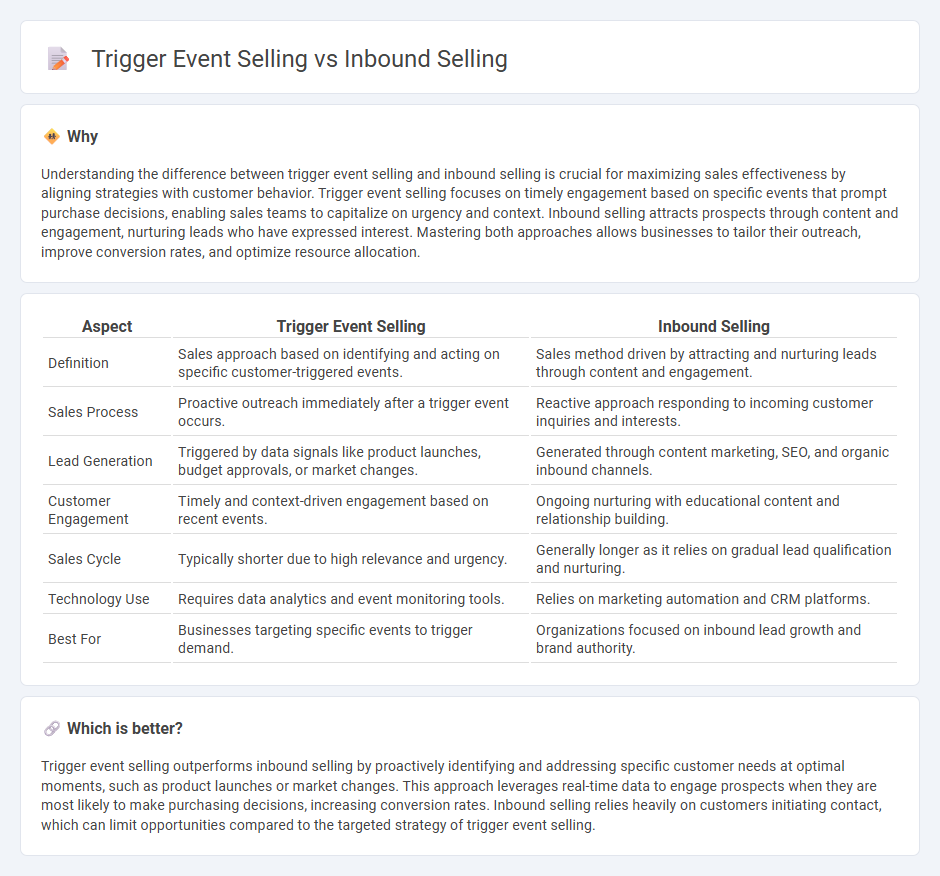
Trigger event selling leverages specific customer actions or significant business changes to initiate sales conversations, targeting prospects at moments of heightened need or urgency. Inbound selling focuses on attracting and engaging potential buyers through content and resources that address their problems, fostering organic interest and trust over time. Explore how combining trigger event selling with inbound strategies can optimize your sales effectiveness.
Why it is important
Understanding the difference between trigger event selling and inbound selling is crucial for maximizing sales effectiveness by aligning strategies with customer behavior. Trigger event selling focuses on timely engagement based on specific events that prompt purchase decisions, enabling sales teams to capitalize on urgency and context. Inbound selling attracts prospects through content and engagement, nurturing leads who have expressed interest. Mastering both approaches allows businesses to tailor their outreach, improve conversion rates, and optimize resource allocation.
Comparison Table
| Aspect | Trigger Event Selling | Inbound Selling |
|---|---|---|
| Definition | Sales approach based on identifying and acting on specific customer-triggered events. | Sales method driven by attracting and nurturing leads through content and engagement. |
| Sales Process | Proactive outreach immediately after a trigger event occurs. | Reactive approach responding to incoming customer inquiries and interests. |
| Lead Generation | Triggered by data signals like product launches, budget approvals, or market changes. | Generated through content marketing, SEO, and organic inbound channels. |
| Customer Engagement | Timely and context-driven engagement based on recent events. | Ongoing nurturing with educational content and relationship building. |
| Sales Cycle | Typically shorter due to high relevance and urgency. | Generally longer as it relies on gradual lead qualification and nurturing. |
| Technology Use | Requires data analytics and event monitoring tools. | Relies on marketing automation and CRM platforms. |
| Best For | Businesses targeting specific events to trigger demand. | Organizations focused on inbound lead growth and brand authority. |
Which is better?
Trigger event selling outperforms inbound selling by proactively identifying and addressing specific customer needs at optimal moments, such as product launches or market changes. This approach leverages real-time data to engage prospects when they are most likely to make purchasing decisions, increasing conversion rates. Inbound selling relies heavily on customers initiating contact, which can limit opportunities compared to the targeted strategy of trigger event selling.
Connection
Trigger event selling and inbound selling are connected through their focus on timely customer engagement driven by specific actions or needs. Trigger event selling leverages real-time data and signals such as company funding, product launches, or executive changes to initiate targeted sales conversations. Inbound selling complements this approach by capitalizing on the interest generated by these events, guiding prospects who have shown intent through content or inquiries toward a purchase decision.
Key Terms
**Inbound Selling:**
Inbound selling centers on attracting potential customers through valuable content and personalized engagement, aiming to address their needs as they initiate contact. This method leverages SEO, social media, and content marketing to guide prospects through the buyer's journey naturally. Explore how inbound selling strategies can transform your lead generation and conversion rates.
Buyer Persona
Inbound selling centers on understanding the Buyer Persona's needs, behaviors, and pain points to attract and engage prospects through tailored content and solutions. Trigger event selling targets specific moments or changes in the Buyer Persona's environment, such as company expansions or regulatory shifts, to initiate timely, relevant sales conversations. Explore how mastering both strategies can enhance your sales effectiveness by aligning with your Buyer Persona's journey.
Content Marketing
Inbound selling leverages content marketing by attracting prospects through valuable, educational content tailored to their needs and search intent, fostering trust and engagement over time. Trigger event selling uses content strategically around specific events--such as product launches or market changes--to capitalize on immediate buyer intent and urgency. Explore effective content marketing strategies to master both inbound and trigger event selling approaches.
Source and External Links
What is Inbound Sales? Methodology, Strategies & More - Salesloft - Inbound selling is a modern sales framework that creates personalized buying experiences by identifying active and passive buyers, connecting with them, exploring their needs, and advising solutions thoughtfully.
Inbound Selling: How to Meet Buyers Where They Are - Docket AI - Inbound selling is a customer-focused approach that attracts, engages, and guides buyers by building trust and providing value first, rather than pushing products aggressively.
Inbound Sales: Definition, Processes, Best Practices - Yesware - Inbound selling helps sales reps engage buyers who research independently by sharing insights and relevant content, resulting in better-qualified leads and stronger trust throughout the buying journey.
 dowidth.com
dowidth.com